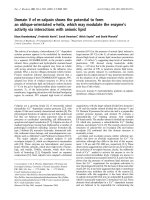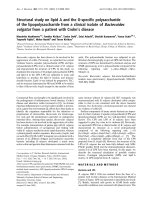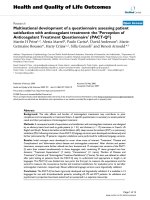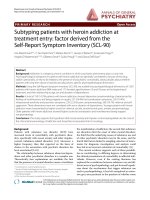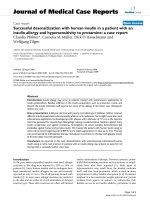Luận án TS Y học: Patient satisfaction with inpatient services at the national referral
Bạn đang xem bản rút gọn của tài liệu. Xem và tải ngay bản đầy đủ của tài liệu tại đây (2.96 MB, 84 trang )
Taipei Medical University
School of Health Care Administration
Master’s Thesis
Patient satisfaction with inpatient services at the national referral
hospital of Belize
Graduate Student: Tisa C. Grant
Advisor: Che-Ming Yang, M.D., J.D., Ph.D.
June, 2012
I
ACKNOWLEDGEMENTS
I give thanks to God for the completion of this thesis requirement, for grace, mercy, and
guidance throughout my time at Taipei Medical University, and for all the people and opportunities
He has placed in my path on this academic journey. I have been blessed and the names are too
numerous to mention. I can only hope that each individual knows who he/she is, the profound
difference each made and that my sincere gratitude has been sufficiently and appropriately
expressed to each one.
To my advisor, Dr. Che-Ming Yang, and my committee members, thank you for your
guidance, your patience, and for being firm but kind. To the management and staff of Karl Heusner
Memorial Hospital (KHMH) and the survey respondents, without your help this simply would not
have been possible and I thank you!
To my family and dear friends for their support of this aspiration, their reassurances,
assistance, encouragement and patience to the very end of this milestone, I give my heartfelt thank
you.
II
ABSTRACT
Title of thesis: Patient satisfaction with inpatient services at the national referral hospital
of Belize
Author: Tisa C. Grant
Thesis advised by: Che-Ming Yang, M.D., J.D., Ph.D.
Background - The Ministry of Health in Belize has implemented several policies and service level
agreements to improve patient satisfaction country wide. Although these initiatives rely on results to
appropriately measure patients’ satisfaction with the quality of care, the extent to which a patient’s
experience explains his or her satisfaction with the health-care system remains unclear.
Objectives - Despite what may appear to be the general consensus on health care services provided
nationally, some health care experiences may very well be more influential than others to the patient
in forming their overall satisfaction level. The objective of this study is to ascertain the effects that
specific variables have on patients’ overall evaluation of hospital care and their intention to
recommend the hospital.
Methods - The HCAHPS Survey was self-administered at the national referral hospital of Belize to
inpatients. Simple and multiple step-wise linear regression models were used to identify the
predictor factors of patient satisfaction using, separately, the two dependent variables: “Overall
evaluation of hospital care” and the “Intention to recommend the hospital”, controlling for age,
gender, ethnicity, education and perceived health.
Results - It was found that patient’s highest priority was communication with nurses and doctors
encompassing courtesy and respect, taking the time to explain things, and listening to the patients
carefully.
Discussion - From the patient’s perspective, the quality of care must include not only the quality of
medical care provided but also the quality of caring associated with it. Health-care managers and
other decision makers may need to remind their nurses and staff members that patients are
III
experiencing an intensely critical and emotional moment, and thus, they need to provide patient-
centered care
Keywords: Patient satisfaction, inpatient, Belize, developing country
IV
TABLE OF CONTENT
ACKNOWLEDGEMENTS I
ABSTRACT II
TABLE OF CONTENT IV
LIST OF TABLES VI
LIST OF FIGURES VII
CHAPTER 1: INTRODUCTION 1
1.1 Background 1
1.2 Belize: The Healthcare System and the People 2
1.3 Statement of the Problem 5
1.4 Significance of the Study 8
1.5 Research Objectives 10
CHAPTER II: LITERATURE REVIEW 11
2.1 Definition of Patient Satisfaction 11
2.2 Development of HCAHPS Survey Instrument 12
2.3 Determinants of Patient Satisfaction 14
2.4 Clinical Staff Influence on Patient Satisfaction 15
2.5 Patient Demographic and Patient Satisfaction 16
2.6 Summary 17
CHAPTER III: METHODOLOGY 18
3.1 Conceptual Framework 18
3.2 Operational Definitions of Variables 19
3.3 Hypotheses 23
3.4 Survey Instrument 25
3.5 Study Setting 26
3.6 Study Sample 27
3.7 Data Source and Collection 28
3.8 Data Analyses 29
3.9 Ethical Consideration 34
V
CHAPTER 4: RESULTS 35
4.1 Samples’ characteristics 35
4.2 Descriptions of the variables 35
4.2.1 Categorical variables description for ‘Overall evaluation of Hospital Care’ 35
4.2.3 Mean age difference between “Overall Evaluation of Hospital” and “Care Intention to
recommend” 36
4.3 Univariate and multivariate analysis for predicting “Overall evaluation of hospital care” 42
4.4 Univariate and multivariate analysis for predicting “Intention to recommend” 45
CHAPTER 5: DISCUSSION 48
5.1 Hospital care factors as predictors of patient satisfaction 48
5.2 Implications of patient demographics on patient satisfaction 50
5.3 Perceived health as a predictor of satisfaction 52
5.5 Recommendations 54
5.6 Implications for further research 55
5.7 Conclusion 57
APPENDIXES 63
Appendix I – HCAHPS Survey Instrument 63
Appendix II – Ethical Approval Request Letter 70
Appendix III – Ethical Approval Letter 71
Appendix IV – Patient Consent Form 72
VI
LIST OF TABLES
Table 1: Operational definitions of variables 20
Table 2: Reliability test results 30
Table 3: Recoding of variables 31
Table 4: Description of categorical variables by frequency and percentage (N=176) 37
Table 5: Description of the categorical variables for “Overall evaluation of hospital care” 38
Table 6: Description of the categorical variables for ‘Intention to recommend’ 39
Table 7: Mean age difference between rating group for overall evaluation of hospital care (N=169)
40
Table 8: Mean age difference between rating group of ‘Intention to recommend’ (N=168) 41
Table 9: Univariate analysis of independent variables to predict overall evaluation of hospital care
43
Table 10: Multivariate analysis of all independent variables to predict overall evaluation of Hospital
Care 44
Table 11: Univariate analysis of independent variables to predict intention to recommend 46
Table 12: Multivariate analysis of independent variables to predict intention to recommend 47
VII
LIST OF FIGURES
Figure 1 - Conceptual Framework for Patient Satisfaction at the National Referral Hospital of
Belize. 18
1
CHAPTER 1: INTRODUCTION
1.1 Background
Patient satisfaction (or customer satisfaction) is a term that is widely used with reference to
health care. Identified as an integral factor in the evaluation of health care, the inclusion of ‘patient
satisfaction’ measurements and interpretation can easily go unquestioned. In fact, quality of care
reforms and health care delivery in developed countries such as the United States of America and
Europe allow for an increasingly important role of patient satisfaction as an indicator (Bleich,
Ö zaltin, & Murray, 2009). However, at the hospital level, many clinicians appear unconvinced of
the usefulness of satisfaction measures. Since clinicians are often more concerned about treatment
outcomes, their skepticism may be attributed to the belief that other indicators of healthcare quality
such as how patients feel about the cost and/or accessibility of services, the food, interpersonal
relationships and overall satisfaction levels are administrative issues (Hudak & Wright, 2000).
Over the years, health care managers have utilized various methods, from complaint boxes
to satisfaction surveys, to gather information that can be used to improve patient satisfaction. There
have been many patient satisfaction studies that utilized patient satisfaction surveys, even if the
focus may have been different than it is today. Some studies attempted to learn who, for example,
would be more satisfied (Otani, Herrmann, & Kurz, 2011). Despite the increased focus on
satisfaction as an outcome measure and the growing body of research to support it, satisfaction has
remained difficult to compartmentalize. Although numerous satisfaction surveys have been
developed, most with acceptable psychometric properties, it remains largely unknown the factors
patients use to consider themselves satisfied (Jackson, Chamberlin, & Kroenke, 2001). Patients’
satisfaction with health care in comparison to their experience is increasing in its importance.
Likewise, according to Bleich et al. (2009), the continued interest in comparing people’s
satisfaction with the health system across different countries and time periods suggests the need to
distinguish the relationship between them. Otani et al. (2011) suggested that it is likely that a
positive experience with important factors will result in a good satisfaction overall. Conversely, if
the patient had a negative experience with important factors, the overall satisfaction will be bad.
The extent to which a patient’s experience explains his or her satisfaction with the health-care
2
system remains unclear. Some experiences may very well be more influential than others to the
patient in forming their overall satisfaction level.
1.2 Belize: The Healthcare System and the People
Belize is a former British Colony and the only English-speaking country in Central America,
divided into six districts. It is more similar to other English–speaking Caribbean countries in culture,
politics, and economy. Due to location, however, Spanish is widely spoken (Ministry of Health,
2006a). The area of Belize (mainland and cayes) is 8,867 square miles, the greatest length being 280
kilometers and its greatest width is 109 kilometers. Considered to be a “melting pot of many races”
resulting from the influx of many people of Central America, Asia, Europe and the Caribbean
(Ministry of Health, 2006a), the population is now at 312,698 based on the 2010 population census
(The Statistical Institute of Belize, 2011).
The population census also shows that the five main ethnic groups are Mestizo, Creole,
Maya, Garifuna and Mennonite. Mestizo is the largest group (50%), Creole accounted for 21%,
Maya and Garifuna made up 10% and 4.6%, respectively. Other ethnic groups in Belize are East
Indian, Chinese, Arabs and Africans, among others. The ethnic groups, however, are heavily
intermixed. Although, English is the official language of Belize, English Creole is widely spoken. It
remains a distinctive part of everyday conversations for most Belizeans. However, Spanish is
spoken as a first language for majority of the people in the northern districts, the north of the Belize
District, and the Cayo District in the west. In the southern Districts, there are people whose first
language is Garifuna or Maya.
The basic structure for health care delivery is provided by a network of seven district
hospitals which are divided into four regions: Northern Region (Orange Walk and Corozal Districts),
Central Region (Belize District), Western Region (Cayo District) and Southern Region (Stann
Creek and Toledo Districts) with the Karl Huesner Memorial Hospital (KHMH), the Central
Regional Hospital, being the national referral hospital (Ministry of Health, n.d.). In terms of
population, the Central Health Region is the biggest of the four health regions of the country and
therefore, provides health care services to 30.5% of the entire population of the country. The Region
has three administrative areas: Belize City, Belize Rural and the Cayes. As the commercial capital,
3
Belize City is considered the ‘bustling metropolis’ of the country and attracts local and international
visitors, thus increasing the servicing population by 6% (Ministry of Health, n.d.). As a result, the
Belize District has the greatest density of health care providers relative to its population (Pan
American Health Organization, 2009a) with a total of 285 staff members (Ministry of Health, n.d.).
There were 2,283 workers employed in the health system in 2009, 1279 (56%) were health
care providers while the remaining 1004 (44%) were administrative and other support staff. About
43% of health care providers were employed in the Belize District. There are approximately 30
nationalities and ethnic groups represented in the Belize health care provider workforce, Mestizo
and Creole totaling 61%. Of the 1279 health care providers (i.e. clinical workers and health
professionals) about 80% are employed in the public sector. Between 2005 and 2009, the number of
registered nurses remained relatively stable while the number of specialists fell from 159 to 60. The
combined ratio of registered nurses and physicians per 10,000 population dropped from 23.3 in
2005 to 17.7 in 2009. Among the five, major ethnic groups in Belize, Mestizo and Mayans are not
well represented in the health care provider workforce (36% combined) although together they
represent 63% of the total population. Women are 68% of the health care provider workforce,
outnumbering men 2.2 to 1 (Pan American Health Organization, 2009a). This ratio is reflective of
the results of the 2010 population census which reported that “women outnumber males by a ratio
of two to one at the university level” and “in terms of highest level of education completed, females
outnumber males from secondary to university level” (The Statistical Institute of Belize, 2011). It
should be noted, however, that to date, most physicians and physician-specialists have been trained
abroad (in the Caribbean or neighboring Central American Countries). Local training for nurses and
midwives is provided at the national university.
Current social indicators for the country include Infant Mortality Rate (18.4 for 1,000 live
births in 2005), Maternal Mortality Rate (5 deaths per 1,000 live births in 2005), Life Expectancy at
Birth Life expectancy at birth (72.2 years in 2005), Crude Birth Rate (25.6 births per thousand in
2005) Crude Mortality Rate (4.7 deaths per 1,000 population in 2005) (Government of Belize, n.d.),
among others. In order to improve the health status of the nation, the Ministry of Health envisions
“a national health care system which is based upon equity, affordability, accessibility, quality and
sustainability in effective partnership with all levels of government and the rest of society in order
to develop and maintain an environment conducive to good health” (Ministry of Health, 2010). For
years, the only public health insurance provided was that of the social security scheme established
in 1981, which primarily insures employees against injury on the job, maternity and pension
4
benefits. However, more than a decade ago, a National Health Insurance (NHI) scheme was
established under the Social Security Amendment Act of August 2001 to provide comprehensive
healthcare services. NHI is a strategy developed by the Government, as part of its Health Sector
Reform program, to provide health care services to all residents of Belize. The strategy is derived
from the need to provide an improved, equitable and sustainable system of health care to the people
of Belize. An initial pilot project was launched on the south side of Belize in August 2001 and still
continues today to facilitate decision making in the nationwide implementation of NHI and its
financing mechanism (Social Security Board, 2009).
5
1.3 Statement of the Problem
Patient satisfaction is an important quality outcome indicator of health care in the hospital
setting and is considered in the total quality of care more widely in developed nations than in
developing nations (Singh, Mustapha, & Haqq, 1996; Syed Saad, 2001). While strides are being
made to develop technical efficiency or improve facility, patients’ perception of and satisfaction
with the quality of care beyond the treatment outcome often lags behind. Health care that is
perceived as less than quality can potentially discourage patients from using the available services.
According to Syed (2001), patients will underutilize, bypass, and use as a measure of last resort a
system that fails to guarantee a certain level of quality. In Belize, Many individuals cross the border
from Belize to take advantage of services and supplies in the neighboring countries of Guatemala
and Mexico (Pan American Health Organization, 2009b). Others, such as urban users with financial
ability, choose among various providers for specific types of service in the private sector. This trend
has increased in the last five years. Rural users, on the other hand, do not have this privilege, since
the private sector has developed primarily in the urban areas (Pan American Health Organization,
2002).
In developing countries, such as Belize, the issue of public medical facilities has become a
topic of current concern. Some members of the population vocally condemn the quality of service at
these facilities, particularly the national referral hospital, KHMH. Such expressions have been given
prominence in the media from the time. Because actual surveys have not been conducted regarding
patients’ satisfaction, much is left to speculation and it cannot be justly determined that the quality
of service at KHMH is in fact poor or over-sensationalized by the media. Despite the pioneering
efforts of the Government of Belize (GOB) and the Ministry of Health (MOH) - Belize is the first
Caribbean nation to implement a National Health Information System and National Health
Insurance - and the many other structural changes being made (physically and administratively), the
negative public opinion remains.
In 1994, the Government of Belize signed a technical co-operation document with the
International Development Bank (IDB) which financed a project to offer technical assistance in the
assessment of Belize’s health system. Four major policy areas were defined after the two–year
diagnostic phase was completed. Management and infrastructure, systems organization and
regulation and financing were the major problems identified. Management issues, for example
included over-centralized command and control in the Ministry of Health, health facilities and
6
programs were often managed by medical doctors without management training, inadequate supply
of well trained health professionals, especially medical specialists and managers. Others
demonstrated minimal commitment to patient care, poor accountability, discipline, attendance and
“customer service” (Ministry of Health, 2006a).
The Pan-American Health Organization/World Health Organization (PAHO/WHO), through
the Public Health in the Americas Initiative, defined 11 Essential Public Health Functions (EPHF)
necessary to strengthen public health practice. EPHF 9, which covers quality assurance of personal
and population based health services, is carried out by the Regulatory Unit and National Health
Insurance (NHI). This EPHF 9 was one of three to receive the lowest scores after an assessment of
the health system by MOH and PAHO. In response, clinical protocols were developed and
implemented for 40 medical conditions. A Complaints Policy and Reporting and Resolution
Mechanism have been developed (Pan American Health Organization, 2002).
Since then, the Ministry of Health has initiated several projects to introduce systems that
would assist in improving the publics' confidence in the public health care system. One such scheme
was the patient feedback system, developed through their current Complaints Mechanism to
improve customer satisfaction. All health care providers are trained to understand and respect
patients' beliefs and values and to protect patient’s dignity through the provision of respectful care.
These added interpersonal skills are intended to support the complaint mechanism and to assure
patients satisfaction. Ensuring that patients are informed of, understand, and act when they believe
their rights have been violated; as well as, ensuring that patients understand that they too have a
responsibility for their health care, are among the responsibilities of the health care provider. One
study found that the ratings of clinician listening or interest were indeed associated with greater
patient satisfaction and this can be done through the implementation of communication-based
interventions or training programs that aim to improve clinicians’ warmth and listening (Henry,
Fuhrel-Forbis, Rogers, & Eggly, 2012). The health system of Belize is not specifically designed to
accommodate this function, but under the National Health Insurance Scheme, (NHIS) more
emphasis is being placed on patient satisfaction as an indicator of the health system’s response to
the needs of communities (Pan American Health Organization, 2009b).
Health service level agreements (SLA) were initiated during 2001 to 2004 in all four health
regions for provision of primary, secondary, and tertiary health. The principal goal of these SLAs is
to “strengthen the optimal provision of health care services for all populations within the framework
of access, equity, quality of care, efficiency, patient satisfaction, and harmonizing the health care
7
service delivery in Belize” (The Cameron Health Strategies Group Limited, 2009). The SLAs define
the relationship between the provider function and regulator function of the regional health services
and MOH, respectively. These agreements rely on the evaluation of results as a means to measure
institutional and management performance relative to the goals and targets defined within the
agreements (Ministry of Health, 2006a). The availability of reliable and timely information to
support the decision making process, however, is a problem in Belize. This is being addressed so
that administrative decision making can be information based (Pan American Health Organization,
2002)
8
1.4 Significance of the Study
In most Western health care systems, particularly the developed nations, patients are
generally allowed to choose their own physicians. In the absence of assigning patients to different
facilities, it is sometimes very difficult to tell whether continual use of a service eventually lead to
satisfaction, or if satisfaction, in fact, leads to continuity and is likely to be bidirectional (Saultz &
Albedaiwi, 2004). Likewise in Belize, to increase efficiency in the health system internally and
holistically, under the Belize Social Security Board – National Health Insurance (BSSB-NHI)
scheme, it is the patient’s right to select their physician (Pan American Health Organization, 2002).
The Vision for Belize’s Health Workforce, as documented in the Belize’s Health Workforce
Strategic Plan 2010 – 2014, is for Belize to have a sustainable health workforce that is
knowledgeable, skilled and adaptable. The plan is for the health workforce, suitably trained and
competent, to be distributed as such to achieve equitable health outcomes. Once the workforce are
valued and working within a supportive environment and culture, they will be better able to provide
safe, quality, preventative, curative and supportive care, that is “population and health consumer
focused and capable of meeting the health needs of the Belizean” (Ministry of Health, 2010)
The ‘Licensing and Accreditation Standards for Hospitals and In-patient Health Facilities’
manual, divided into six major sections, approved in July 2009, is intended to focus on the entire
hospital. The first set of standards, Patient-Centered Standards, focuses on the patient and those
functions involved in diagnosing, treating and educating patients. The second set of standards,
Health Care Organization Management Standards, focuses on functions involved in the overall
effective and efficient management of the health care facility (Ministry of Health, 2009) which is as
much a part of patient satisfaction.
Under the ‘Quality Management Standards”, level one of subsection 2.2.1 – Quality
Leadership - the inpatient facility should carry out activities intended to evaluate the quality of care.
The quality of professional performance, within the establishment, can be demonstrated and
guaranteed by the use of patient satisfaction surveys, department specific surveys, and others.
Administering surveys actually formed part of the Operational Plan for 2010 (Ministry of Health,
2010) but the mode of delivery and whether those were administered is unclear at this time.
Conducting this survey at KHMH, which is considered the ultimate level for in-patient and
specialized care in Belize (Ministry of Health, 2006b), will set in motion all the regulations and
policies implemented thus far to ultimately improve the health care services received by patients,
9
and by extension, their satisfaction. All quality improvement efforts without an evaluation process
to measure success are futile and who better can confirm their satisfaction but the patients
themselves. This survey will set the stage for future inpatient satisfaction surveys and studies at the
National referral hospital and influence management decision making in quality of care
improvement initiatives such as staff training, etc. In the long run, it is hoped that a survey
instrument that captures Belize’s unique demographic, culture and health system in its measurement
of patient satisfaction, can be developed and applied nationally as a part of a national reporting
system. Such a system will inform the public of the performance of the health facility they choose
(private and public, inpatient and outpatient) as well as play an integral part in informing the
decisions made by MOH in the accrediting and licensing procedures and the overall improvement
of the health system in aggregate.
10
1.5 Research Objectives
1. Evaluate the effect of hospital care factors (communication with nurses, communication
with doctors, responsiveness of hospital staff, staff care, and the hospital environment)
on patients’ overall evaluation of hospital care and their intention to recommend the
national referral hospital of Belize.
2. Evaluate the effect of patient’s perceived health on their overall evaluation of hospital
care and their intention to recommend the national referral hospital of Belize.
3. Evaluate the effect of socio-demographic factors (age, gender, education, and ethnicity)
on patient’s overall evaluation of hospital care and their intention to recommend the
national referral hospital of Belize.
11
CHAPTER II: LITERATURE REVIEW
2.1 Definition of Patient Satisfaction
The ultimate validation of quality care is patient satisfaction (Donabedian, 1997). In today’s
health care realm, patient satisfaction is an important quality outcome indicator of health care,
particularly in the hospital setting. The interesting situation, however, is that the attention to patient
satisfaction has gone far beyond a clear definition of its meaning and measurement (Yellen, Davis,
& Ricard, 2002). Because of the way in which meaning influences the design and interpretation of
measures, Hudak & Wright (2000) exacts that ambiguity about the meaning of satisfaction itself is
in fact the dominant weakness in this field of inquiry.
Subjective factors are important sources of bias when using patient satisfaction in quality
measurement. For example, the fulfillment of a patient’s expectations as a quality indicator would
mean if a patient had low expectations of a hospital prior to their visit, then any poorly performing
hospital could potentially be ranked highly (Bjertnaes, Sjetne, & Iversen, 2012). Although it is
believed that expectations are an important predictor in conceptual models of patient satisfaction,
the effect of expectations is rarely assessed empirically, despite the observed effects of the
instrument on expectations (Peck et al., 2001). For the purpose of this research, we will utilize a
simple definition of patient satisfaction which is a patient-reported outcome measure (Bjertnaes et
al., 2012).
12
2.2 Development of HCAHPS Survey Instrument
Hospital Consumer Assessment of Healthcare Providers and Systems (HCAHPS), also
known as CAHPS Hospital Survey, is a core set of questions that can be combined with a
customized set of hospital-specific items. Whether used alone or in conjunction with other outcome
measures such as clinical process outcomes, the scope and metrics of health care quality is
expanded (Giordano, Elliott, Goldstein, Lehrman, & Spencer, 2010).
HCAHPS is a joint developmental effort by the Agency for Healthcare Research and
Quality (AHRQ) and the Centers for Medicare & Medicaid Services (CMS), implemented in the
United States in October 2006 (Goldstein, Farquhar, Crofton, Darby, & Garfinkel, 2005). HCAHPS
was implemented on a voluntary basis by participating hospitals (approximately 50% of the 2600
eligible) and quickly gained support. For the 2008 fiscal year, certain hospitals reimbursed through
Inpatient Prospective Payment Systems (IPPS) were required to report results of the survey in order
to receive their Annual Payment Update (APU).
The Quality Assurance Guidelines V6.0 provided three broad goals which shaped the
HCAHPS survey.
First, the survey is designed to produce comparable data on the patient perspective on care
that allows objective and meaningful comparisons between hospitals on domains that are
important to consumers.
Second, public reporting of the survey results is designed to create incentives for hospitals to
improve their quality of care.
Third, public reporting will serve to enhance public accountability in health care by
increasing the transparency of the quality of hospital care provided in return for the public
investment (Centers for Medicare & Medicaid Services, 2012).
The initial research and testing phase of HCAHPS included a 2000 call for measures, survey
and item development in 2002-2003, and a subsequent pilot test in the same year. A longer version
of the survey was administered to 49,812 inpatients in 132 hospitals in Arizona, Maryland, and New
York (Goldstein et al., 2005). Standardized survey administration protocols were developed and
implemented to balance the principles of comparability and flexibility (Giordano et al., 2010).
The HCAHPS survey consists of 27 items (1 to 22 include 18 substantive items used in
publicly reported measures and 4 screener items used to determine eligibility of patients for a subset
13
of the 18 substantive items. Items 23 to 27 are demographic in nature and are used in patient-mix
adjustment). The 18 substantive items include 14 report items used to construct 6 composite
measures (communication with nurses, communication with doctors, responsiveness of hospital
staff, pain management, communication about medicines, and discharge information). The 2
individual items are cleanliness of hospital environment and quietness of hospital environment; and
2 global ratings (overall rating of hospital and willingness to recommend this hospital (Giordano et
al., 2010).
